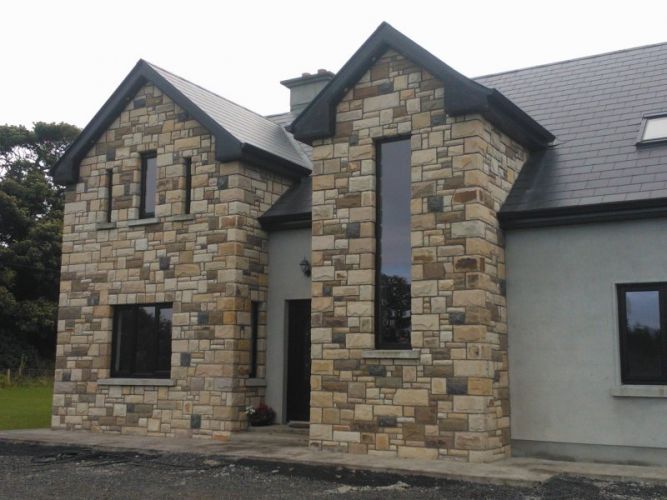Natural stone cladding
Natural stone cladding is the use of a thin layer of stone as a cladding for the outside of a structure. It is also sometimes used on internal surfaces. When applied properly, the thin layers achieve a textured and three-dimensional appearance, giving the impression that the structure is constructed entirely of natural stone.
Typically, stone cladding is used:
- To give a stone finish to an existing structure.
- To create a stone finish at lower weight, and so with reduced structural support requirements.
- To allow faster and lower cost installation.
- To allow modern the use of modern construction techniques and high-performance detailing, but with a traditional appearance.
- To allow off-site manufacturing, with reduced on-site construction.
- To reduce waste.
Stone cladding is manufactured by quarrying natural stone and milling it into thin pieces. A range of different sizes, thicknesses, shapes and patterns can be created according to the specification of the design. Cladding can be supplied either as single stone pieces, or as large, bespoke panels prefabricated form a number of pieces, such as storey-height panels or shaped parts such as reveals and lintels.
To accommodate the weight of natural stone, the cladding system should be fixed mechanically to structural substrate layers. This can be done using shelf angles or specially-made stone clips.
Alternatively, cladding panels can be made by laminating thin pieces of stone onto a carrier panel made from lightweight concrete. Because the two materials have similar physical characteristics, they work well together as a composite and provide good weather protection.
Where very thin stone pieces are used (around one inch thick), providing a final finish to a substrate such as blockwork, this may be described as a 'stone veneer'.
[edit] Related articles on Designing Buildings Wiki
- Ashlar.
- Brick.
- Brick veneer.
- Building fabric.
- Building with structural stone.
- Choosing stone.
- Cladding.
- Defects in stonework.
- Inspecting stone sample panels.
- Limestone for building.
- Masonry.
- Natural stone.
- Natural stone tiles.
- Patio stone.
- Pebbledash.
- Rustication.
- Stone dressing.
- Sustainable stone.
- Tufa and tuff
- Types of stone.
- Wall types.
Featured articles and news
RTPI leader to become new CIOB Chief Executive Officer
Dr Victoria Hills MRTPI, FICE to take over after Caroline Gumble’s departure.
Social and affordable housing, a long term plan for delivery
The “Delivering a Decade of Renewal for Social and Affordable Housing” strategy sets out future path.
A change to adoptive architecture
Effects of global weather warming on architectural detailing, material choice and human interaction.
The proposed publicly owned and backed subsidiary of Homes England, to facilitate new homes.
How big is the problem and what can we do to mitigate the effects?
Overheating guidance and tools for building designers
A number of cool guides to help with the heat.
The UK's Modern Industrial Strategy: A 10 year plan
Previous consultation criticism, current key elements and general support with some persisting reservations.
Building Safety Regulator reforms
New roles, new staff and a new fast track service pave the way for a single construction regulator.
Architectural Technologist CPDs and Communications
CIAT CPD… and how you can do it!
Cooling centres and cool spaces
Managing extreme heat in cities by directing the public to places for heat stress relief and water sources.
Winter gardens: A brief history and warm variations
Extending the season with glass in different forms and terms.
Restoring Great Yarmouth's Winter Gardens
Transforming one of the least sustainable constructions imaginable.
Construction Skills Mission Board launch sector drive
Newly formed government and industry collaboration set strategy for recruiting an additional 100,000 construction workers a year.
New Architects Code comes into effect in September 2025
ARB Architects Code of Conduct and Practice available with ongoing consultation regarding guidance.
Welsh Skills Body (Medr) launches ambitious plan
The new skills body brings together funding and regulation of tertiary education and research for the devolved nation.
Paul Gandy FCIOB announced as next CIOB President
Former Tilbury Douglas CEO takes helm.
UK Infrastructure: A 10 Year Strategy. In brief with reactions
With the National Infrastructure and Service Transformation Authority (NISTA).
























Comments
A must read book for any civil engineer
STONE CLADDING ENGINEERING
https://www.springer.com/us/book/9789400768475